Northeast Medical Institute - New Haven Campus Phlebotomy Course & Cna Class Can Be Fun For Anyone
Northeast Medical Institute - New Haven Campus Phlebotomy Course & Cna Class Can Be Fun For Anyone
Blog Article
Northeast Medical Institute - New Haven Campus Phlebotomy Course & Cna Class Fundamentals Explained
Table of ContentsThe 8-Second Trick For Northeast Medical Institute - New Haven Campus Phlebotomy Course & Cna ClassThe 3-Minute Rule for Northeast Medical Institute - New Haven Campus Phlebotomy Course & Cna ClassThe 6-Minute Rule for Northeast Medical Institute - New Haven Campus Phlebotomy Course & Cna ClassThings about Northeast Medical Institute - New Haven Campus Phlebotomy Course & Cna ClassExcitement About Northeast Medical Institute - New Haven Campus Phlebotomy Course & Cna ClassNortheast Medical Institute - New Haven Campus Phlebotomy Course & Cna Class Things To Know Before You Buy
The usage of such tools should be gone along with by various other infection prevention and control methods, and training in their use. Not all safety devices apply to phlebotomy. Before picking a safety-engineered device, users should completely explore readily available tools to identify their suitable use, compatibility with existing phlebotomy methods, and effectiveness in securing personnel and patients (12, 33).For setups with low resources, price is a motoring consider procurement of safety-engineered devices - PCT Training. Where safety-engineered tools are not offered, skilled usage of a needle and syringe is acceptable. Accidental direct exposure and particular information about an incident should be videotaped in a register. Assistance services need to be advertised for those who undertake unexpected direct exposure.
One of the essential markers of high quality of care in phlebotomy is the participation and participation of the patient; this is mutually helpful to both the wellness worker and the patient. Clear info either created or spoken should be available per patient who undertakes phlebotomy. Annex F provides sample message for clarifying the blood-sampling treatment to a person. In the blood-sampling space for an outpatient department or center, give a comfy reclining sofa with an arm rest.
Some Known Facts About Northeast Medical Institute - New Haven Campus Phlebotomy Course & Cna Class.
Make sure that the signs for blood sampling are plainly specified, either in a composed protocol or in documented directions (e.g. in a lab kind). Accumulate all the devices needed for the procedure and place it within risk-free and easy reach on a tray or cart, guaranteeing that all the things are plainly visible.
Where the patient is adult and aware, follow the steps outlined below. Present yourself to the individual, and ask the patient to specify their full name. Examine that the laboratory type matches the individual's identification (i.e. match the patient's details with the laboratory type, to make sure exact identification). Ask whether the patent has allergies, fears or has actually ever passed out throughout previous injections or blood attracts.
Make the client comfortable in a supine setting (preferably). Place a tidy paper or towel under the patient's arm. Discuss the test to be carried out (see Annex F) and obtain spoken consent. The person has a right to decline a test at any moment prior to the blood sampling, so it is necessary to ensure that the client has understood the treatment.
An Unbiased View of Northeast Medical Institute - New Haven Campus Phlebotomy Course & Cna Class
Extend the patient's arm and check the antecubital fossa or lower arm. Locate a blood vessel of a good size that shows up, straight and clear. The representation in Area 2.3, reveals common placements of the vessels, yet numerous variations are possible. The average cubital capillary exists in between muscles and is usually the most simple to puncture.
DO NOT insert the needle where capillaries are drawing away, because this enhances the chance of a haematoma. Situating the blood vessel will help in determining the right size of needle.
Haemolysis, contamination and visibility of intravenous liquid and medicine can all modify the outcomes (39. Nursing personnel and physicians might access central venous lines for specimens following protocols. Samplings from main lines lug a threat of contamination or erroneous research laboratory examination results. It serves, yet not visit site suitable, to draw blood specimens when initial presenting an in-dwelling venous gadget, prior to linking the cannula to the intravenous liquids.
Northeast Medical Institute - New Haven Campus Phlebotomy Course & Cna Class - The Facts
Failure to permit adequate contact time boosts the threat of contamination. DO NOT touch the cleansed website; in specific, DO NOT put a finger over the capillary to lead the shaft of the exposed needle.
Ask the client to develop a fist so the veins are more popular. Enter the vein swiftly at a 30 level angle or much less, and proceed to present the needle along the blood vessel at the most convenient angle of access - CNA Training. When sufficient blood has been gathered, release the tourniquet BEFORE withdrawing the needle
Getting The Northeast Medical Institute - New Haven Campus Phlebotomy Course & Cna Class To Work
Withdraw the needle delicately and apply mild pressure to the website with a clean gauze or completely dry cotton-wool sphere. Ask the patient to hold the gauze or cotton woollen in place, with the arm expanded and raised. Ask the individual NOT to flex the arm, since doing so creates a haematoma.

The Of Northeast Medical Institute - New Haven Campus Phlebotomy Course & Cna Class
Where possible, keep the tubes in a shelf and relocate the rack towards you - https://packersmovers.activeboard.com/t67151553/how-to-connect-canon-mg3620-printer-to-computer/?ts=1719616718&direction=prev&page=last#lastPostAnchor. If the sample tube does not have a rubber stopper, infuse very slowly into the tube as minimizing the stress and speed used to move the sampling minimizes the danger of haemolysis.

Report this page